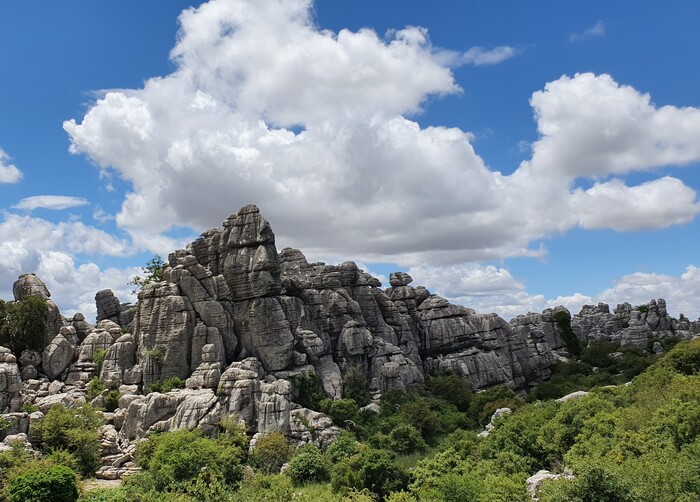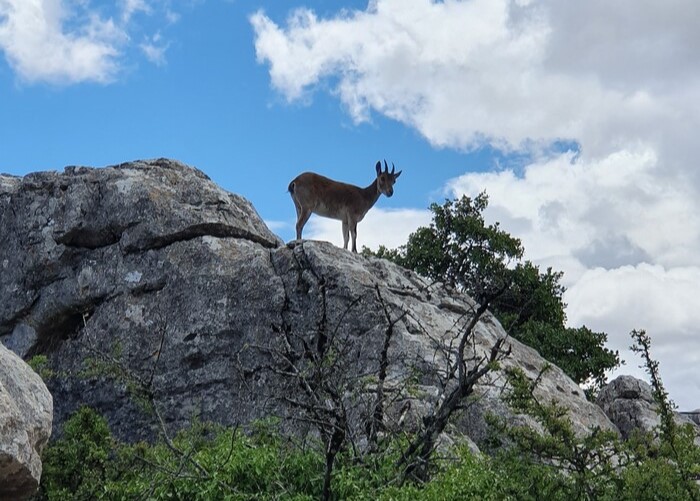For children, El Torcal de Antequera is a climbing paradise. For adults, it’s a breathtakingly beautiful landscape that leaves them short of eyes. The lucky ones sometimes come face to face with an Iberian ibex
The nature reserve is less than an hour’s drive from Málaga. The steep and picturesque C 3310 road leads from Antequera through hairpin bends to the park’s entrance. Along the way, we see many farms, abandoned fincas, picturesque valleys, and rabbits hopping away in the verges filled with colorful wildflowers. The higher we go, the more barren and grey the landscape becomes. The vegetation lessens, and the views become more stunning. We are heading to the El Torcal de Antequera nature park, which covers about twelve square kilometers and consists of four geologically distinct parts.
Of these four parts, Torcal Alto is the most famous, with three not-too-long but beautiful hiking trails. Here, the jagged forms of the stone towers are most dominantly present. A rocky ridge – called Las Villaneras, separates this part from Torcal Bajo. This is similar to Torcal Alto but less spectacular. The highest point of the park, El Camorro de las Siete Mesas, lies at 1,339 meters in this ridge. The Sierra Pelada in the east is a vast area that from a distance resembles a site of Roman ruins. Passages between the limestone rocks form regular stone patterns, interspersed with shrubbery. The highest point in this section is 1,198 meters.
The fourth part, Los Tajos y Laderas, borders almost the entire area and is most remarkable from the south. Offering a perfect view of the village Villanueva de la Concepción at the foot of El Torcal.
The origin
This marvelous piece of nature was formed by a geological process that took millions of years. Consequently, it is one of the most impressive examples of karst landscape in Europe. The term ‘karst’ encompasses all geological processes related to the erosion of limestone by water. During the Jurassic period, (between 250 and 150 million years ago), ocean waves washed over this part of the Iberian Peninsula.
The immense pressure of the water mass compressed the stacked limestone sediments on the seabed, altering their structure with salt. The seabed slowly emerged from the water between the African and European continents to rise more than 1,300 meters above the then sea level. The limestone plateau that now forms El Torcal dates from the Jurassic period and resembled a gigantic, petrified sponge on the seabed due to the karst process.
Millions of years of exposure above sea level then subjected the landscape to various water influences in the form of ice, springs, streams, and rainwater. Furthermore, numerous fractures in the Earth’s crust also led to the formation of ravines and split parts. Mother Earth, acting as a meticulous but conscientious artist, skillfully used these ‘tools’ to continuously shape the strange forms we can now admire in El Torcal.
Three Easy Trails to Choose From
The yellow trail
You can usually park at the El Torcal visitor center. On busy weekend days or during holiday seasons, you might not get that far and shuttle buses run back and forth. Therefore, it’s advisable to visit El Torcal on weekdays or outside the summer months. Three easy and short hiking trails are marked in green, yellow, and orange, all starting from the parking lot. The green trail takes forty-five minutes and the yellow about two hours. The orange trail is not much longer but is slightly more challenging with more climbing. The routes are clearly marked with posts and colored arrows painted on the rocks.
Ibexes and flowers
The children run excitedly ahead, climbing on every high rock along the path. And there are quite a few. Nature here has placed enormous boulders that sometimes seem to be made up of vertical slabs. Some rocks resemble petrified apartment buildings at least five stories high, giving the feeling of being on another planet. Mysterious-looking passages invite exploration off the path.
Currently (we wrote this article early June 2020), it’s lushly green and dotted with colorful flowers. Tiny pink and white flowers grow from rock crevices. We see so many ibexes that it’s surprising. They’re probably still used to the quiet from the recent lockdown measures. We’re often studied from a distance by their velvet eyes or spot their majestic antlers above the rugged rock formations. It’s incredible how quickly these brown creatures move over the nearly vertical rock faces.
Nature museum full of stone sculptures
The hiking trails in El Torcal follow a labyrinth of passages between stacked blocks of stone. Some are as tall as multiple houses, interspersed with grassland, shrubbery, and many young holm oaks. Wear good shoes, as paths are uneven and often slippery, even in dry weather. Every few meters, a new bizarre combination of sculptures becomes visible, forming a sort of natural open-air museum. With a little imagination, it’s possible to play an extensive game of ‘I spy.’ The stones of El Torcal are as fine co-players in this game as clouds typically are from a field in Northern Europe. The only requirements are a good pair of eyes and some imagination to discern numerous existing figures from the rocks.
We saw a giant tortoise about ten meters long and three meters high. Elsewhere, a petrified camel tempted us to climb it, and a rock shaped like a dragon with an outstretched neck seemed to menace its surroundings. Other rocks had already been named El Sombrecillo (little sun hat), La Maceta (flowerpot), El Macetón (large flowerpot), and La cara del perro (dog’s face).
El Tornillo del Torcal
The most famous symbol in Torcal Alto has become the symbol of the park itself and declared a geological monument. El Tornillo del Torcal is named for its resemblance to a screw (tornillo), or especially its thread. Nine large flat discs appear to lie loosely on top of each other, but upon closer inspection, they are actually one piece.





